A division is a large military unit or formation, usually consisting of between 6,000 and 25,000 soldiers. In most armies, a division is composed of several regiments or brigades; in turn, several divisions typically make up a corps.

The Italian front was one of the main theatres of war of World War I. It involved a series of military engagements in Northern Italy between the Central Powers and the Allies of World War I from 1915 to 1918. Following secret promises made by the Allies in the 1915 Treaty of London, the Kingdom of Italy entered the war on the Allied side, aiming to annex the Austrian Littoral, northern Dalmatia and the territories of present-day Trentino and South Tyrol.

The First Battle of the Masurian Lakes was a German offensive in the Eastern Front 2–16 September 1914, during the Russian invasion of East Prussia. It took place only days after the Battle of Tannenberg where the German Eighth Army encircled and destroyed the Russian Second Army. Using the rapid movements aided by the East Prussian railway network, the Eighth Army reformed in front of the spread-out Russian First Army and pushed them back across their entire front, eventually ejecting it from Germany. Further progress was hampered by the arrival of the Russian Tenth Army on the Germans' right flank.
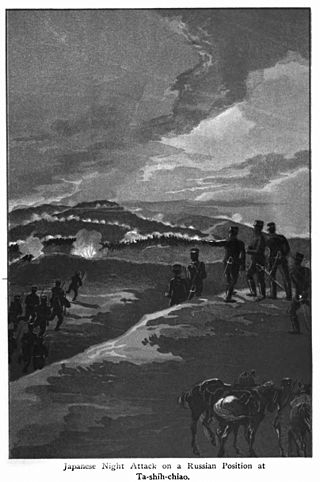
The Battle of Tashihchiao was a land engagement fought on 24–25 July 1904, during the Imperial Japanese Army's advance toward Liaoyang in first stage of the Russo-Japanese War. Tashihchiao is located about 25 kilometres (16 mi) southwest of the city of Haicheng, in present-day Liaoning Province, China. The town of Tashihchiao was of strategic importance in the Russo-Japanese War, as it was a railroad junction between the main line on the Russian South Manchurian Railway and a spur which led to the old treaty port of Yingkou (Newchwang). Control of both was essential for further advances by Japanese forces towards Liaoyang and Mukden.
This is an order of battle of the French and German Armies at the beginning of the Franco-Prussian War in 1870.

The British Expeditionary Force order of battle 1914, as originally despatched to France in August and September 1914, at the beginning of World War I. The British Army prior to World War I traced its origins to the increasing demands of imperial expansion together with inefficiencies highlighted during the Crimean War, which led to the Cardwell and Childers Reforms of the late 19th century. These gave the British Army its modern shape, and defined its regimental system. The Haldane Reforms of 1907 formally created an Expeditionary force and the Territorial Force.
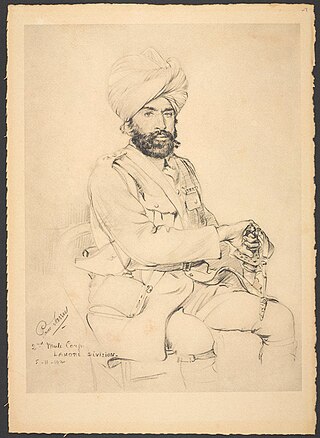
The 3rd (Lahore) Division was an infantry division of the Indian Army and before 1895, the Bengal Army, first organised in 1852. It saw service during World War I as part of the Indian Corps in France before being moved to the Middle East where it fought against troops of the Ottoman Empire.
This is the order of battle for the ground forces involved in Operation Crusader, a World War II battle between the British Commonwealth and the European Axis Powers of Germany and Italy in North Africa between 18 November – 30 December 1941.

Mikhail Ivanovich Zasulich was a general in the Imperial Russian Army, noted for his role as commander of the Russian 2nd Siberian Army Corps in the Battle of the Yalu River, of the Russo-Japanese War of 1904–1905.
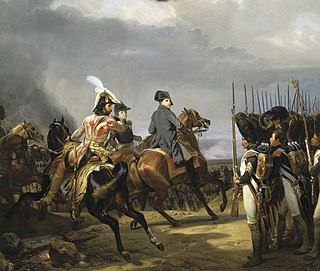
The Jena-Auerstedt campaign order of battle is listed below. The order of battle includes units from the First French Empire and the Kingdom of Prussia that fought each other in the campaign that included the decisive Battle of Jena-Auerstedt on 14 October 1806. The order of battle may be useful to trace the battles of Schleiz and Saalfeld, which occurred before Jena-Auerstedt, as well as battles and capitulations that happened after 14 October, such as Erfurt, Halle, Prenzlau, Pasewalk, Stettin, Waren-Nossentin, and Lübeck.

The Battle of Berlin was the final major campaign of the European Theatre of World War II, fought between Nazi Germany's Wehrmacht and the Soviet Union's Red Army. It began with the Battle of the Seelow Heights on 16 April 1945 and concluded with the Battle in Berlin.
The VII Corps of the Grande Armée was a French military unit that existed during the Napoleonic Wars. It was formed in 1805 and assigned to Marshal Pierre Augereau. From 1805 to 1807, Augereau led the VII Corps in the War of the Third Coalition and the War of the Fourth Coalition. It was disbanded after being nearly wiped out at the Battle of Eylau in February 1807 and its surviving troops were distributed to other corps.
The VIII Corps of the Grande Armée was a French military unit that existed during the Napoleonic Wars. Emperor Napoleon I formed it in 1805 by borrowing divisions from other corps and assigned it to Marshal Édouard Mortier. Marshal André Masséna's Army of Italy was also reorganized as the VIII Corps at the end of the 1805 campaign. The corps was reformed for the 1806 campaign under Mortier and spent the rest of the year mopping up Prussian garrisons in western Germany.
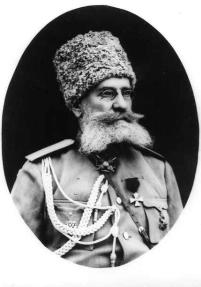
The 1st Caucasus Army Corps was a military formation of the Russian Empire which existed between 1847 and 1918, including the period during World War I.

The 1st Siberian Rifle Artillery Brigade was an artillery brigade of the Russian Imperial Army attached to the 1st Siberian Rifle Division of the 1st Siberian Army Corps. The unit was founded in 1851 and took part in the Russian intervention in the Boxer Rebellion, the Russo-Japanese War, and World War I before being demobilized in 1918 following the Russian Revolution.

The 2nd Manchurian Army was a field army of the Russian Empire that was established in 1904 during the Russo-Japanese War, to operate in Manchuria against Japan. It was one of the three such armies that were created and was disbanded in September 1905 after the end of the War.
The Structure of the Egyptian Expeditionary Force over the course of the First World War is shown below.
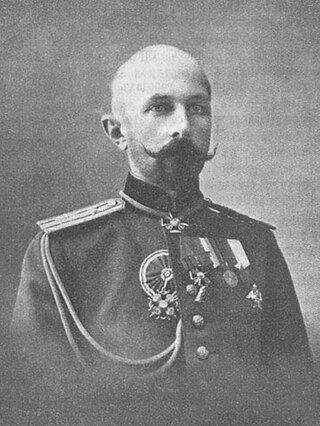
Prince Vladimir Georgievich Kantakuzen was a Russian major general who saw action in the Russo-Japanese War and the First World War.

First Battle of Przasnysz was a battle between Imperial German Army and Russian troops which took place between 7–28 February 1915, on the Eastern Front during World War I.

The 9th German Army acted versus the Russian armies west of the Vistula River. After the completion of the fighting at Humin and Wola Szydłowska, there was some calm in this sector, especially before the Russian 2nd Army. But, having received the task of pinning down the Russian troops here, the commander of the German 9th Army, General of the Cavalry August von Mackensen, decided by going on the offensive not only to help the Austro-Hungarian troops in the Carpathians, but, if successful, push back Russian 5th Army to Warsaw.













